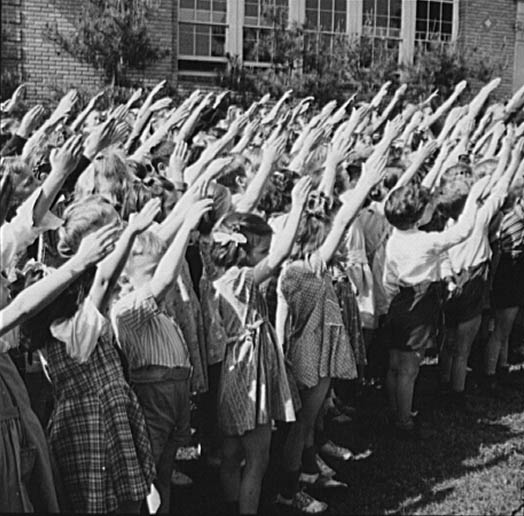Historical cheap shots
Here's a pretty old post from the blog archives of Geekery Today; it was written about 17 years ago, in 2008, on the World Wide Web.
Here’s a photograph of a group of elementary school youth, practicing a patriotic ritual devised by a famous self-identified National Socialist, from May 1942. Can you guess where this photograph was taken, and what their country’s Office of War Information was having them swear an oath of loyalty to?

If you somehow didn’t see through the obvious trick question, and if recent discussions here haven’t already tipped you off, well, then, maybe this will help:

At a signal from the Principal the pupils, in ordered ranks, hands to the side, face the Flag. Another signal is given; every pupil gives the flag the military salute — right hand lifted, palm downward, to a line with the forehead and close to it. Standing thus, all repeat together, slowly,
I pledge allegiance to my Flag and the Republic for which it stands; one Nation indivisible, with Liberty and Justice for all.At the words,to my Flag,the right hand is extended gracefully, palm upward, toward the Flag, and remains in this gesture till the end of the affirmation; whereupon all hands immediately drop to the side.–Francis Bellamy, in The Youth's Companion, 65 (1892): 446–447.
Here’s the details. This was the standard gesture that students, in participating schools, were forced to make every day for just about exactly 50 years, as they recited the different versions of the Pledge of Allegiance. By 1942, current events made for some discomforting similarities, and the gesture was widely dropped in favor of the now-familiar hand-on-heart gesture (although certain traditionalist groups, such as the D.A.R., held out into 1943 before they finally gave up on the arm-out salute).
A cheap shot? Sure, I’ll cop to that. But I will say, by way of self-justification, that aesthetics and style and symbolism are all more important than we sometimes give them credit for being, in everyday life, and especially in trying to understand the parts of us and our neighbors, which certain political moods express, which certain political voices (or registers) try to speak to, and which certain political movements try to grab ahold of for their own purposes. A superficial similarity isn’t always an irrelevant one.
I’m just sayin’.
The fact that most Americans today can’t even imagine how society could function without a powerful central government is evidence that this type of propaganda has worked very well.
“A superficial similarity isn’t always an irrelevant one”
This is right in line with a larger project I’m working on: most Americans today will dismiss any comparisons to Naziism because, well, “get back to me when we start building ovens.”
As if that was the only thing the Nazis did that was evil. And as if when it gets to that point, it won’t already be too late. (I don’t think we’ll be like the Nazis, because of cultural factors, but the Stalinists or Maoists. As many have noted, though, they don’t provoke the same revulsion as the Nazis do).